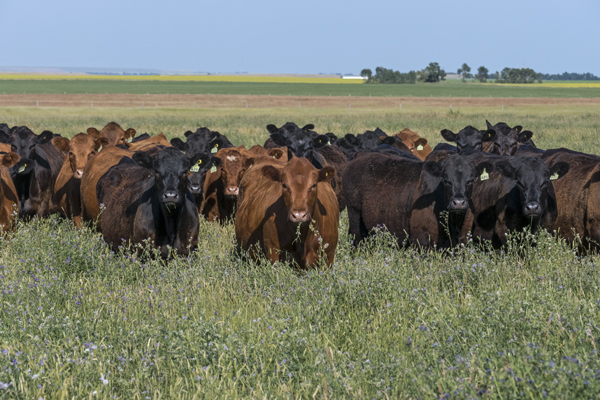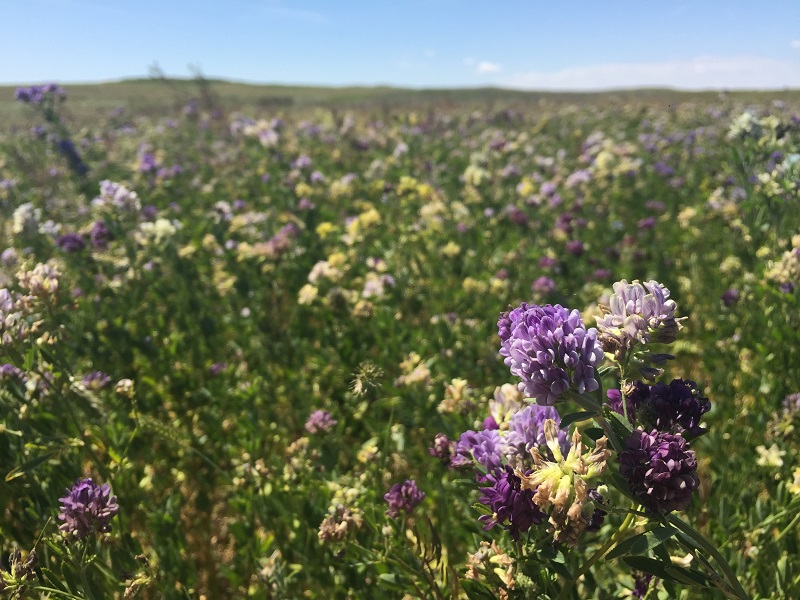Adapting to a Changing Climate
This article written by Dr. Reynold Bergen, BCRC Science Director, originally appeared in the April 2022 issue of Canadian Cattlemen magazine and is reprinted on the BCRC Blog with permission of the publisher.

I had a National Geographic poster of “Ice Age Mammals of the Alaskan Tundra” on my bedroom wall when I was a kid. It showed herds of prehistoric muskoxen, horses, wolves, lemmings, bears, lions, mammoths, camels, saber-toothed tigers, mastodons and humans marauding across a vast, grassy expanse 12,000 years ago. The muskoxen, bears, wolves and lemmings still live in Alaska. The lions, camels and horses moved to other parts of the world where the climate suited them better. The saber-toothed tigers, mammoths and mastodons went extinct. When archaeologists found the frozen remains of these animals, they dug deeper and uncovered the fossils of duckbilled dinosaurs from millions of years earlier when conditions were hot and tropical.
Earth’s climate is always changing. Volcanoes, bogs, soil and animals exhale greenhouse gases, and plants and the oceans absorb them. Since industrialization, human burning of fossil fuels has emitted greenhouse gases faster than the natural environment can sequester them. Climate models predict how changing greenhouse gas levels will impact future global temperature and precipitation patterns.
Climate models resemble economic models – both are constantly being tweaked and improved as better data becomes available, and both are subject to “noise” that temporarily obscures long-term trends. Economic forecasters consider historical and current data about an industry and the larger economy to predict future trends. Unforeseen shocks like BSE or a pandemic cause significant short- to medium-term disruptions that might make people think the economic model is broken. But over time, long-term trends shine through (e.g., trends towards agricultural consolidation with fewer and larger pharmaceutical and equipment companies, farms, feedlots, packers and retailers). Similarly, volcanoes, solar dimming or cyclical El Nino or La Nina weather patterns can temporarily obscure long-term climate trends. Even if we don’t like where trends are pointing, understanding them can help us respond appropriately.
In 2020, Agriculture and Agri-Food Canada researchers Vern Baron (Lacombe) and Gilles Bélanger (retired) co-authored the “Climate, Climate-Change and Forage Adaptation” chapter in a book called “Forages: The Science of Grassland Agriculture, Volume II (Seventh Edition).” This chapter covered a lot of ground, but here’s what stood out for me.
By the middle of this century, climate models predict that Canadian provinces will average 1 to 3oC warmer than now. That doesn’t sound like much, but there’s more. Warmer air will mean warmer soil, which may benefit some plants but stress others. Weather variability will also increase. Warmer air and ocean currents can alter jetstreams and precipitation patterns. B.C., Ontario, Quebec and Atlantic Canada are predicted to generally become wetter, with more of their precipitation coming in heavy rainfall events during the growing season. The prairies are expected to see less precipitation, with most of it falling in winter and spring. The growing season will be hotter and drier, with perhaps two weeks of temperatures over 28oC instead of one. Canada will have more frost-free days, and grassland areas are predicted to gradually expand further north and east into areas of the prairies and Ontario that are currently forested.
Carbon dioxide is a nutrient for plants, so higher CO2 levels can help plants grow and use water more efficiently. But if temperatures are too high, and/or moisture is limiting, plants won’t be able to take advantage of the elevated CO2. Overall, forage productivity is predicted to increase in Eastern Canada and decline on the prairies.

But in an ironic twist, “global warming” may increase the risk of winterkill. Take alfalfa as an example. While having proportionally more spring moisture may improve alfalfa germination in Western Canada, a warmer, drier growing season may make it harder for those seedlings to establish healthy roots and survive long-term.
This will make it more important to ensure that alfalfa persists well in established forage stands. But if warmer, drier conditions mean alfalfa is the only green forage remaining in late summer and fall, grazing pressure may increase. Overgrazing weakens alfalfa and makes it more prone to disease and winterkill. Less snowfall across the country could leave the crown of the plant unprotected, and further increase the risk that alfalfa will die out of the stand. Periodic warm spells in winter may cause alfalfa plants to lose their dormancy and then fatally freeze if colder winter weather resumes. These aren’t new problems, but climate change will make them bigger, and will also make appropriate harvest and grazing management practices even more important than they already are.
I had hoped that these challenges could be solved by taking forages that already grow in warm, dry places (like the southwestern US) seeding them in Western Canada, or by seeding forages from warm, damp places (like the southeastern US) in Eastern Canada. But that won’t work. Plants are highly sensitive to daylength. Perennial plants that grow well further south where daylength is more uniform throughout the year may not survive further north, where days rapidly become much longer in summer and shorter in fall. Instead, we’ll need to genetically improve the species that already perform well here to help them adapt to future conditions. Upcoming columns will talk about researchers’ efforts to do that.
The Beef Cattle Research Council is funded by the Canadian Beef Cattle Check-Off. The BCRC partners with Agriculture and Agri-Food Canada, provincial beef industry groups and governments to advance research and technology transfer supporting the Canadian beef industry’s vision to be recognized as a preferred supplier of healthy, high-quality beef, cattle and genetics.
Click here to subscribe to the BCRC Blog and receive email notifications when new content is posted.
The sharing or reprinting of BCRC Blog articles is typically welcome and encouraged, however this article requires permission of the original publisher.
We welcome your questions, comments and suggestions. Contact us directly or generate public discussion by posting your thoughts below.